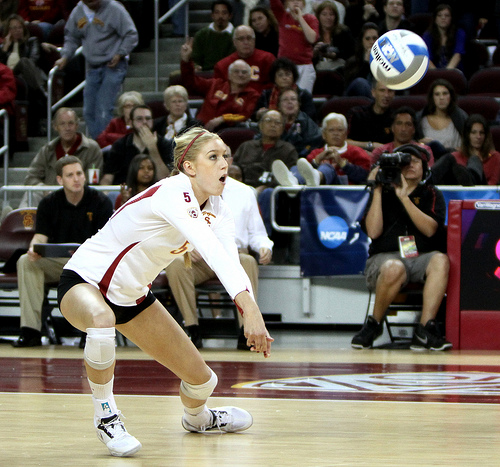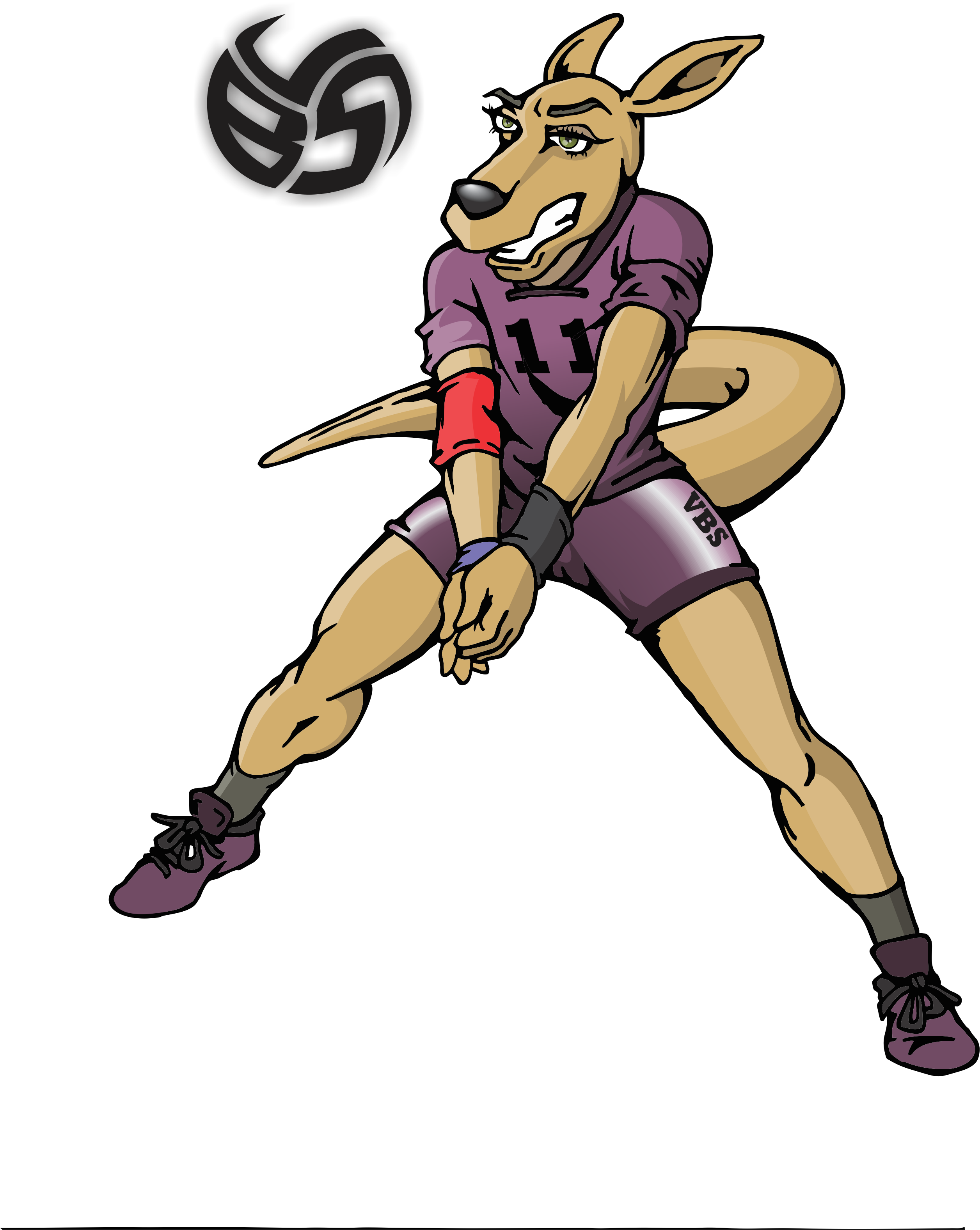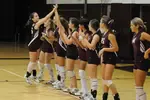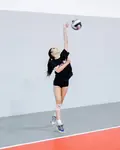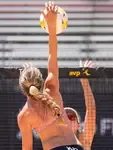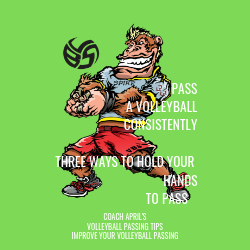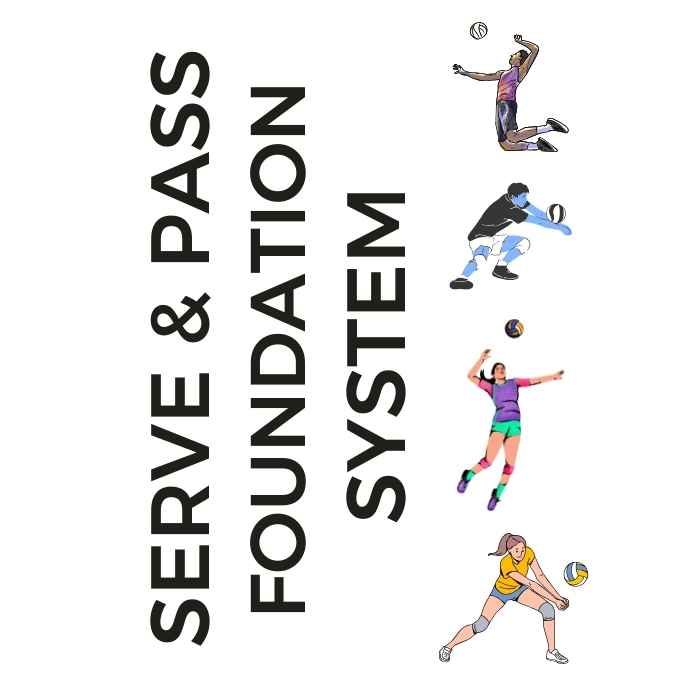
Serve + Pass Foundation System: The Complete Skills Arsenal The two-skill mastery system that transforms inconsistent players into the athletes coaches build their lineups around. Stop Struggling With The Two Most Important Skills In Volleyball!
- Improve Your Volleyball with Coach April
- How To Play Volleyball
- How To Pass in Volleyball
How To Pass In Volleyball Better With This Ball Control Passing Guide
Ball control is the biggest part of learning how to pass in volleyball consistently to your setter when your team is in serve receive formation.
 To forearm pass a volleyball you clasps both arms together at the wrists, usually one palm of the hand inside the other while contacting the ball on the forearms
To forearm pass a volleyball you clasps both arms together at the wrists, usually one palm of the hand inside the other while contacting the ball on the forearmsWhen you learn how to pass in volleyball you
- clasp both arms together at the wrists, usually one palm of the hand inside the other
- while contacting the ball on the forearms, specifically the area above the wrists and below the inside of the elbow.
How to Pass in Volleyball
When Do You Forearm Pass?
I like to work on this 3 person "Dodgeball" drill where the person in the middle has to choose which side to get their midsection out of the way of the oncoming ball that's being tossed at their chest before they present their passing platform with an angled shoulder positioned towards the target.
The forearm pass is usually performed by one of three to five players on a team that is receiving the serve from the team on defense.
The first person to contact the ball on the team that's in serve receive, uses "the pass", to get the ball to their setter.
Another example when you may have to forearm pass a volleyball is during the second contact, if you're a setter and you can't get your hands on the ball fast enough to set it.
You can form a platform and bump set the ball passing it instead of setting it to one of your hitters to spike the ball over the net.
How To Pass In Volleyball
Keep Your Hips Low
Controlling the pass, also called "controlling the ball" or "volleyball ball control" is a big part of becoming a very good passer.
 When you hips are the same height or higher than the ball its harder to control it and the ball shoots over the net instead of to the setter or you shank it so no one can get to it.
When you hips are the same height or higher than the ball its harder to control it and the ball shoots over the net instead of to the setter or you shank it so no one can get to it.With your hips lower than the oncoming served ball you can get under it and give it lift from a better angle with your legs without swinging your arms.
When you're lower than the ball you can give it lift using your legs to help guide the ball.
When your hips are the same height or higher than the ball its harder to control it and the ball shoots over the net instead of to the setter or you shank it so no one can get to it.
How To Pass In Volleyball
Keep Shoulders Over Your Knees
Portland State and my Tstreet Vegas 18s middle blocker Naomi working on passing the ball to the target repeatedly from left back also known as Zone 5.
Do not stand up to pass.
One common mistake passers make is to pull their shoulders back behind their knees when they make contact with the ball while passing.
In other words they stand up to pass the ball especially when the ball is served high at them.
Instead we teach passers to keep their shoulders over their knees when contacting the ball and let the ball come down low.
If you stand up or pull your shoulders back when passing, you also pull the ball back so it stays closer to you in the backrow.
The setter will have to chase the ball and work harder to get to it to try and set it instead of getting a pass inside the ten foot line which allows her to run an in-system offense.
You want to make a good pass close to or just inside the ten foot in Zone 3 so your setter doesn't have to come to the backrow to set a ball.
Karch Kiraly Volleyball Quote on the Importance of Passing a Ball
Karch Kiraly on the Importance of the Forearm Pass
(Karch Kiraly Volleyball Quote on Passing)
Struggling with passing consistency?
I help talented volleyball players who've been told they're 'not college material' reignite their recruitment dreams... without accepting that crushing verdict... using the same system that just revived my last 18s club libero opportunity to play for her dream college team in New York.
Download my eBook for $7.99 and start building the passing confidence that keeps you on the court—and gets you seen by college coaches.
Do You Follow Me on Pinterest?
Follow me on Pinterest Volleybragswag to improve your game even faster!
I share alot of individual, partner and easy-to-do volleyball serving drills we do in class with my followers.
Many of these volleyball practice drills you can do at home by yourself or try at your next practice with your teammates.
If you're a B team or JV player trying to make varsity next year...your goal should be to complete 1000 reps a day of at least three of the basic skills on your own...volleyball passing, serving and setting should be at the top of the list.
How To Pass in Volleyball:
Where Do You Go From Here?
Where do you need to go now?
Your three options are:
- You can learn more about Passing in volleyball by visiting the Related Links below.
- Follow the suggested reading on our Sitemap page Learning How To Play (Sitemap)
- Or visit the pages in the How to Play Volleyball section in the drop down menu at the top of the page to get started.
- Before leaving this page Say "Hi" to Ms. Resee the Kangaroo, wearing the #11 jersey below. She's a left side hitter with precision passing and a member of the VolleyBragSwag All Beast Third team.
Meet Resee the Kangaroo and Passing Specialist on VolleyBragSwag's All Beast Team
If your athlete struggles with consistent serve receive, gets subbed out, or is overlooked for playing time—this is the fix you’ve been looking for.

Struggling with passing consistency?
I help talented passers tired of getting pulled from games because of inconsistent serve receive skills BUILD passing confidence without expensive private lessons using the same 3-step system that's helped dozens of my athletes get recruited.
Download my eBook for $17.99 and start building the passing confidence that keeps you on the court—and gets you seen by college coaches.
From Lady Vol to Legend: Coach April Produces Powerful Passionate Players...is that you?
What Are You Looking For?
Click to Download Your Pre Serving Ritual Mastery Checklist pdf:
🎯Volleyball Pre Serving Ritual Guide -
Players! Learn How To Transform Your Serve from Weak to Weapon
Click to Download Your Parent's Volleyball Serving Checklist pdf
🎯Parent's Volleyball Serving Checklist Guide
Parents! Help Your Player Develop Championship Serves (Even If You've Never Played)

Hi there!
Thanks for stopping by. Hope you learned something today that will help you reach your volleyball goals.
Be sure to subscribe to my email newsletter so you can learn more each week!
Stay strong! Stay motivated!
-Coach April

SUSCRIBE to my email newsletter below!
 Click to learn more about the weekly volleyball classes and clinics or email info@imrpoveyourvolley.com for information
Click to learn more about the weekly volleyball classes and clinics or email info@imrpoveyourvolley.com for informationCongratulations to my seven Boys-18s Vegas Volley club players who played in two state championship finals yesterday, the 3A and 5A State champinship finals at Sunrise Mountain High School.
TOURNAMENT CHAMPIONS!
A-1 Vegas Volley VBC
In It To Win It Tournament
May 2 - 4, 2025 Tournament
Gold Medalists
18s Premier Division
Vegas Volleyball's Unsung Heroes: Celebrating Moms with Peace Love Volleyball Shirts
Ready to energize your volleyball mom journey?
Subscribe to my 'Producing Powerful Passionate Peaceful Players' email list above on ImproveYourVolley.com.
You'll receive energy-boosting tips, exclusive insights from me, Coach April Chapple on maintaining momentum in volleyball.
Let's power up the Vegas volleyball scene together!
Recent Articles
-
3 Beach Volleyball Hand Grips How Do You Hold Your Hands When Passing?
Dec 20, 25 05:32 PM
The purpose of the volleyball hand grip you use to pass a ball is to help keep your elbows straight and to insure you have a very flat and wide a platform. -
5 Essential Serving Tips from Tennessee's #2 Career Aces Record Holder
Dec 09, 25 11:39 PM
I've identified the 5 essential serving tips that separate confident servers from struggling ones and you'll serve with the confidence that creates aces -
The Volleyball Toss How Consistent Is Your Ball Toss Before You Serve?
Dec 07, 25 12:29 AM
The volleyball toss for the overhand serve needs to consistently be two feet up in the air and one foot in front of front foot which puts the ball in front of your serving arm.
Learn More About The Pass
Passing
Serve Receive
 Resee the Kangaroo Shirts
Resee the Kangaroo Shirts Resee the Volleybragswag Kangaroo Shirts available now.
Resee the Volleybragswag Kangaroo Shirts available now.



